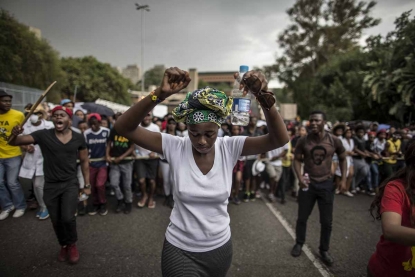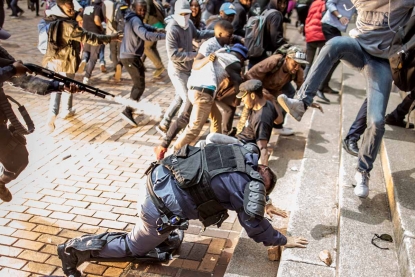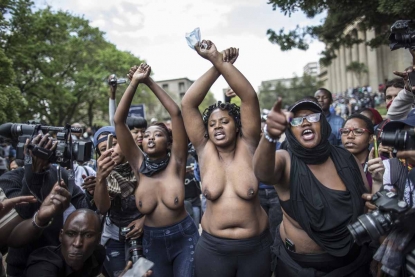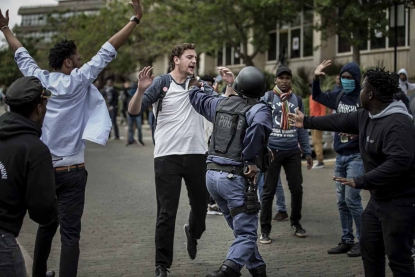A crazy day
Johannesburg -- It was a crazy day, a culmination of various elements that have been brewing and bubbling for weeks during the student protests against raising university fees in South Africa. The university wanted to remain open, the student protesters wanted to shut it down, emotions were running high and there was a heavy police presence.
It was a recipe for disaster and that is exactly what happened.
 (AFP / Mujahid Safodien)
(AFP / Mujahid Safodien)These protests are nothing new. There was a whole movement last year, which ended up forcing the government to abandon planned fee hikes for 2016. The demonstrations started again this year, when the authorities announced that each university would decide on its own whether to increase its fees.
The attendance at these protests has been much smaller than those of last year. It doesn’t mean that it’s less meaningful or less pressing, but it’s interesting to see how these things are evolving.
 (AFP / Marco Longari)
(AFP / Marco Longari)The culture of protest is embedded in the story of South Africa because of apartheid, in which the student protests played such an important part. So it’s interesting to see how this culture of protest is playing out and evolving.
Last year’s protests were marked by a picture that became the quasi face of the movement, of one of the student leaders, a young woman named Nompendula Mkhatswa, walking with her arms raised above her head. It was widely used and shared on social media, so it became a symbol.
 (AFP / Marco Longari)
(AFP / Marco Longari)So when you cover a story like this, you’re aiming to come up with the same level of intensity. And on this particular crazy day, we got a few of them.
First, some context. After weeks of protests, the University of Witwatersrand announced that it would open its doors. There was a lot of pressure for it do so. The school year in South Africa is January to December and in December there is a major exam. So fall is a crucial time, as students have to prepare for this exam. If there is no exam, there is no graduation, it’d be a complete disaster.
 (AFP / Marco Longari)
(AFP / Marco Longari)So on the one hand you had the university determined to reopen and urging all students to attend lectures and activities.
On the other hand, you have the students. This university conducted a poll in which only a very small part of the student population voted to shut it down. So the vast majority wanted to keep going to school, but you had a very determined minority fighting for an issue that they passionately believe in -- they hold that raising fees will prevent the poorest from getting a higher education.
 (AFP / Mujahid Safodien)
(AFP / Mujahid Safodien)And of course you have a heavy police presence. So a recipe for a disaster. The situation boiled over and police intervened. And police did what police usually do in these kind of situations and the students had their say, with running battles with police going on all day, with stones and bricks and things like that.
 (AFP / Mujahid Safodien)
(AFP / Mujahid Safodien)We ended up capturing three really unique moments during the day.
One was when a policeman stumbled on the steps and a protester was trying to kick him in the head. At the same time, in the left side of the photo you have an incredible close-range shot of a rubber bullet being discharged from a rifle. And to top it off, in the background, you have a stun grenade going off, giving the photo a slightly yellow hue. All three things in the same frame, at the same moment. It’s rare to get all of these ingredients coming together at once in a single picture.
 (AFP / Marco Longari)
(AFP / Marco Longari)Then there were two dramatic moments.
One, when a protester offered flowers to the policemen. When shooting a picture like that, all of us with a photography background can’t help but think of Marc Riboud’s iconic photograph from the anti-Vietnam War protests in the US in the late 1960s. There’s just no way that you can get away from the comparison.
 (AFP / Marco Longari)
(AFP / Marco Longari)Another was when young women decided to remove their shirts and bras and go bare-breasted toward the police, pleading with them not to open fire anymore. You have to understand that in African culture, that is a very powerful statement. You don’t expose your body, so when women do this, it’s a true act of defiance.
 (AFP / Marco Longari)
(AFP / Marco Longari) (AFP / Mujahid Safodien)
(AFP / Mujahid Safodien)
From the point of view of coverage, that presented all sorts of complications. You want the power of the moment to be preserved in the picture and that the nudity does not distract you from the message.
When you cover protests like these, be it in Johannesburg, Libreville or Gaza, you follow the same rituals, the same routine. You have to keep watching the things unfolding in front of you, there is a level of risk that you have to consider -- there are stones flying everywhere, rubber bullets, tear gas. So you watch out for yourself and for your colleagues.
 A protest at the university of September 21, 2016.
(AFP / Daylin Paul)
A protest at the university of September 21, 2016.
(AFP / Daylin Paul)And you also have to be very focused because if you’re not, you can miss important shots. For example, the picture that I got, where one of the police officers is holding a protester by his shirt and ends up being surrounded by too many students and reaches for his handgun in his holster.
 (AFP / Marco Longari)
(AFP / Marco Longari)It’s a subtle shot and it speaks volumes and if you’re not focused, you can easily miss it.
This blog was written with Yana Dlugy in Paris.
 (AFP / Marco Longari)
(AFP / Marco Longari)




